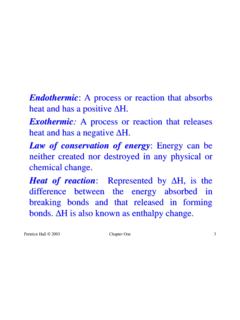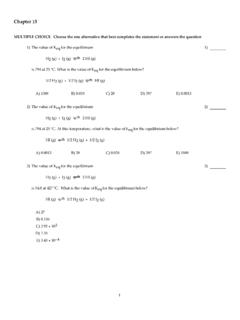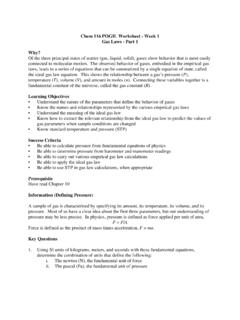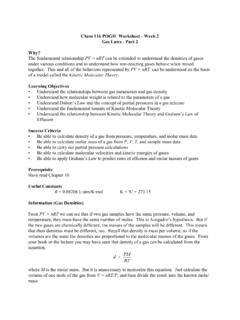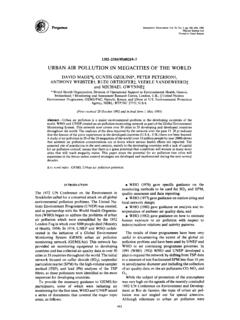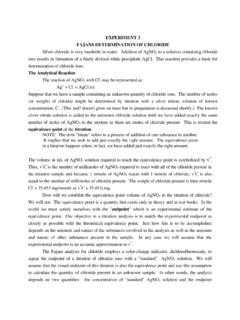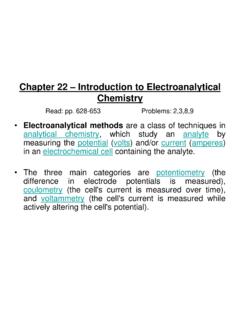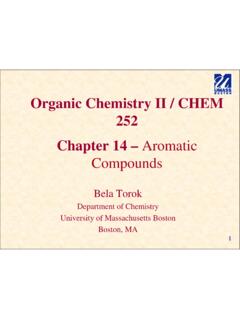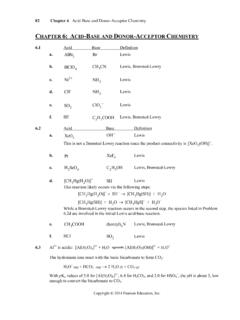Transcription of Organic Chemistry II / CHEM 252 Chapter 20 – Amines
1 Organic Chemistry II / CHEM 252 Chapter 20 AminesBela TorokDepartment of ChemistryUniversity of Massachusetts BostonBoston, MA1 Nomenclature2 Nomenclature Primary aminesare named in systematic (IUPAC) nomenclature by replacing the -eof the corresponding parent alkane with -amine In common nomenclature they are named as alkylamines Simple secondary and tertiary aminesare named in common nomenclature by designating the Organic groups separately in front of the word amine In systematic nomenclature, the smaller groups on the amine nitrogen are designated as substituents and given the locantNNomenclature3 In IUPAC nomenclature the substitutent -NH2is called the aminogroup Aryl Amines The common arylamines have the following names:Nomenclature4 Heterocyclic Amines The important heterocylcic Amines have common names In IUPAC nomenclature the prefixes aza-, diaza-and triaza-are used to indicate that nitrogen has replaced carbon in the corresponding hydrocarbon The nitrogen is assigned position 1 and the ring is numbered to give the lowest overall set of locants to the heteroatomsNomenclature5 Physical Properties6 Physical Properties and Structure of Amines Primary and secondary Amines can form hydrogen bonds to each other and water Tertiary Amines cannot form hydrogen bonds to each other but can form hydrogen bonds to hydrogen bond donors such as water Tertiary Amines have lower boiling points than primary or secondary Amines of comparable molecular weights Low molecular weight Amines tend to be water soluble whether they are primary.
2 Secondary or tertiaryPhysical Properties78 Structure Structure of Amines The nitrogen atom in an amine is sp3hybridized -tetrahedral geometry only the groups -trigonal pyramidal It is usually impossible to resolve amine enantiomers that are chiral at nitrogen because they interconvert rapidly The interconversion occurs through a pyramidalornitrogen inversioninvolving the unshared electron pairStructure9 Quaternary ammonium salts can be resolved into enantiomers Chiral quaternary ammonium salts cannot undergo nitrogen inversion because they lack an unshared electron pair on the nitrogen atom Basicity10 Amines are weak bases Relative basicity of Amines can be compared in terms of pKavalues for their respective conjugate acids The more basic the amine, the higher the pKaof its conjugate acid will be Primary alkyl Amines are more basic than ammonia An alkyl group helps to stabilize the alkylaminiumionBasicity11 gas phase : basicity increases with increasing methyl substitution aqueous solution.
3 Trimethylamine is less basic than dimethyl- or methylamine An alkylaminium ion in water is solvated and stabilized by hydrogen bonding of its hydrogens with water The trimethylaminium ion has only one hydrogen with which to hydrogen bond to water The trimethylaminium ion is solvated less well (and therefore stabilized less) than the dimethylaminium ion, which has two hydrogen atoms for hydrogen bondingBasicity12 Arylaminesare weaker bases than nonaromatic cyclohexylamines The unshared electron pair is delocalizedto the ring The lone pair is less available for protonation, , it is less basic Protonation of aniline is also disfavored because a protonated arylaminehas only two resonance forms Anilinium ion is not as well stabilized by resonance as aniline itselfBasicity13 Basicity of Heterocyclic Amines Nonaromatic heterocyclic Amines have approximately the same basicityas their acyclic counterparts Aromatic heterocyclic Amines (in aqueous solution)
4 Are much weaker bases than nonaromatic aminesBasicity14 Amines versus Amides Amides are much less basic than Amines The pKaof a protonated amide is typically about zero One reason for this much lower basicity is that the amide is greatly stabilized by resonance but the protonated amide is not A more important reason for the weaker basicity of amides is that the nitrogen lone pair is delocalized, amides are protonated at the oxygen Protonation at the oxygen allows resonance stabilization of the positive chargeSalts15 Aminium Salts and Quaternary Ammonium Salts Protonation of Amines with acids leads to formation of aminium salts Aminium salts are formed from 1o, 2oor 3oamines and the aminiumion bears at least one hydrogen Quaternary ammonium salts have four groups on the nitrogen The nitrogen atom is positively charged but does not bear a hydrogen atomSalts16 Quaternary ammonium halides are not basic because they do not have an unshared electron pair on nitrogen Quaternary ammonium hydroxides are very basic because they contain the very strong base hydroxideBasicity17 Solubility of Amines in Aqueous Acid Many aminium chlorides, bromides.
5 Iodides and sulfates are water soluble Solubility of Amines in dilute acid can be used as a chemical test Amides are not basic and are not soluble in aqueous acidsResolving Agents18 Amines as Resolving Agents A chiral amine can be used to resolve a racemic mixture of carboxylic acids by formation of diastereomeric saltsSynthesis of Amines19By Nucleophilic Substitution Reactions Alkylation of Ammonia Reaction of ammonia with an alkyl halide Using an excess of ammonia helps to minimize multiple alkylationsSynthesis of Amines20 Alkylation of Azide Ion followed by Reduction The Gabriel Synthesis for primary aminesSynthesis of Amines21 Preparation of Aromatic Amines by Reduction of Nitro Compounds Aromatic Amines can be synthesized by reduction of the corresponding nitro compound One molar equivalent of hydrogen sulfide in alcoholic ammonia can be used to reduce one nitro group in the presence of another Synthesis of Amines22 Preparation of Primary, Secondary and Tertiary Amines throughReductive AminationSynthesis of Amines23 The reduction can be accomplished using catalytic hydrogenation or a hydride reducing reagent NaBH3CN and LiBH3CN are especially effective in reductive aminationsSynthesis of Amines24 Preparation of Primary, Secondary, or Tertiary Amines through Reduction of Nitriles, Oximes.
6 And AmidesSynthesis of Amines25 Reduction can be accomplished by using catalytic hydrogenation or LiAlH4 Monoalkylation of an amine can be achieved by acylation of the amine and then reduction of the resulting amideSynthesis of Amines26 Preparation of Primary Amines by the Hofmann and CurtiusRearrangements An unsubstituted amide can be converted to a primary amine by formal loss of the amide carbonyl through the Hofmann rearrangement (also called the Hofmann degradation) The first two steps of the mechanism result in N-bromination of the amide The N-bromoamide is deprotonated and rearranges to an isocyanate The isocyanate is hydrolyzed to a carbamate which decarboxylatesto the amineSynthesis of Amines2728 Synthesis of Amines The Curtius rearrangementoccurs through the intermediacy of an acyl azide The acyl azide is obtained from an acid chloride Rearrangement of the acyl azide occurs with loss of N2, a very stable leaving group In the last step, the isocyanate is hydrolyzed by adding waterReactions of Amines29 The lone pair of the nitrogen atom accounts for most Chemistry of Amines The unshared electron pair can act as a base or as a nucleophile The nitrogen lone pair can also make a carbon nucleophilic by resonance30 Reactions of AminesOxidation of Amines Primary and secondary Amines undergo N-oxidation.
7 But useful products are not obtained because of side-reactions Tertiary Amines undergo clean N-oxidationReactions of Amines31 Reactions of Amines with Nitrous Acid Nitrous acid (HONO) is prepared in situby reaction of sodium nitrite with a strong aqueous acid Primary Amines undergo diazotizationwith nitrous acid The unstable diazonium saltsdecompose to form carbocationsReactions of Amines32 Reaction of primary arylamines with nitrous acid results in the formation of relatively stable arenediazonium salts This reaction occurs through the intermediacy of an N-nitrosoamine TheN-nitrosoamine is converted to a diazonium ion Reactions of Amines33 Replacement Reactions of Arenediazonium Salts -Sandmeyer Reactions Aryldiazonium salts react readily with various nucleophilic reagents to give a wide variety of aromatic compoundsReactions of Amines34 Practical Application of replacement with H Example.
8 M-Bromotoluene cannot be made directly from either toluene or bromobenzene N-acetylation is used to reduce the activating effect of the amineReactions of Amines35 Coupling Reactions of Arenediazonium Salts Arenediazonium ions react as electrophiles with highly reactive aromatic compounds such as phenol and aromatic tertiary Amines The reaction is called a diazo coupling reaction Coupling with phenol occurs best in slightly alkaline solution The alkaline solution produces a phenoxide ion that couples more rapidly, if the solution is too alkaline, a nonreactive diazohydroxideis producedReactions of Amines36 Phenol and aniline derivatives undergo coupling almost exclusively at the para position unless this position is blocked Azo compoundsare commonly used as dyes The azo coupling results in compounds which are highly conjugated The -SO3-Na+group is added to the molecule for solubility and to link the dye to the polar fibers of wool, cotton etc.
9 Orange II is made from 2-naphtholReactions of Amines37 SafraninCrystal violet1935 Reactions of Amines38 Reactions of Amines with Sulfonyl Chlorides Primary and secondary Amines react with sulfonyl chlorides to produce sulfonamides A sulfonamide can be hydrolyzed to an amine by heating with aqueous acidReactions of Amines39 The Hinsberg Test This test can distinguish between 1o, 2oand 3oamines An amine and benzenesulfonyl chloride are mixed with aqueous potassium hydroxide; the reaction is acidified in a second step The results are different depending on the class of amine A benzenesulfonamide from a primary amine is soluble in basic solution, but precipitates upon acidificationReactions of Amines40 A secondary amine forms a precipitate directly because an N,N-disubstituted sulfonamide remains insoluble in basic solution There is no acidic hydrogen in an N,N-disubstituted sulfonamide A tertiary amine will not react to form a sulfonamide.
10 But will dissolve upon acidification Acidification converts the amine to a water soluble iminium saltReactions of Amines41 Eliminations Involving Ammonium Compounds The Hofmann Elimination An E2-type reaction occurs when a quaternary ammonium hydroxide is heated An amine is a relatively good leaving group A quaternary ammonium hydroxide can be made from a quaternary ammonium halide using silver oxideReactions of Amines42 Hofmann elimination and other elimination reactions of charged substrates proceed to give the least substituted double bond This is called the Hofmann rule, and the least substituted alkeneproduct is called the Hofmann productReactions of Amines43 The Cope Elimination A tertiary amine oxide will undergo elimination when heated Tertiary amine oxides can be made from tertiary Amines by reaction with hydrogen peroxide the elimination is syn and proceeds via a cyclic transition stat


